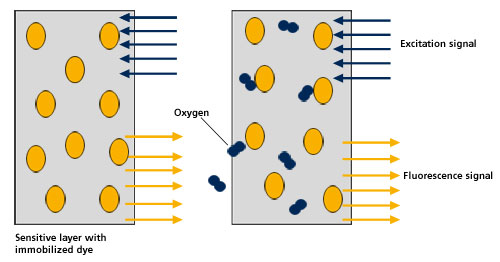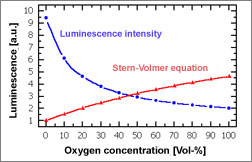The principle of flourescence quenching
The emission characteristic of a specific sensitive dye depends on the oxygen concentration of the surrounding medium.
The fluorescence intensity of the dye decreases when it is quenched by molecular oxygen.
Concerning modulated radiations the decay time is modified and respectively the phase of the fluorescence light if the concentration of the surrounding media changes as well.
The relation between the fluorecence intensity and lifetime in the absence (I0, t0) and presence (I,t) of oxygen concentration [O2] is given by the Stern-Volmer equation:
I0/I = t0/t = 1 + KSV [O2]

Principle of fluroescence quenching |
|
Taking oxygen as analyte for example - the curves in the diagram below represent the sensitivity being increased at lower concentrations compared to higher conentrations of the analyte.

Stern-Volmer equation |
|
| Principle of measurement of optical oxygen sensors: |
Specific and sensitive dyes are generally fixed on permeable membranes. Those may consist of polymeres or Sol gels.
Dyes are stimulated by short-wave light (e.g. blue light) and fluorescence quenching is done in higher wavelength ranges (e.g. red light). Changes in fluorescence lights can be measured using appropriated detectors (such as diode arrays, CCD lines). |
 |
 |